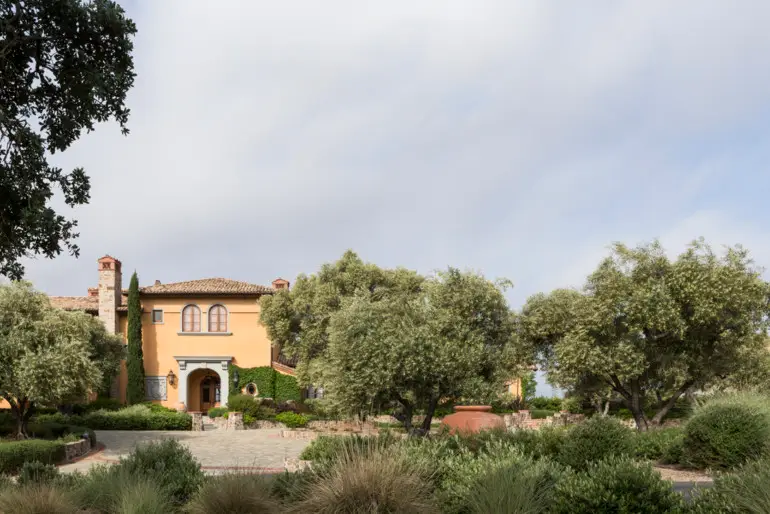An Umbrian-style home in Napa celebrates dining and the good life, Italian-style.
THE GOOD LIFE doesn’t come easy. It took Bay Area architect and interior designer Nestor Matthews, a protégé of the celebrated designer Orlando Diaz-Azcuy, the better part of the last decade and a vast team to work on a single project for clients he describes as Italophiles and consummate connoisseurs.
“The owners have investments in many award-winning restaurants in the Bay Area and their keen interest in food and wine places them firmly among the valley’s food cognoscenti,” the designer says.
As the 11,000-square-foot villa Matthews helped fashion took shape in Napa Valley, his firm, Matthews Studio, designed rooms that are a blend of vintage style and modernity.
The Italianate architecture seems authentic in part because Umbrian architect Riccardo Caracciolo created the master plan for the site. The vineyards were planted first and then came a guesthouse from where the clients spent the next couple of years directing the building of the main house and several ancillary structures. Under the owners’ guidance, several local architects realized Caracciolo’s vision, and landscape designer Frederika Moller added old olive trees to existing stands of live oaks, to lend a sense of age.

“The style of the main stone-and-stucco house alludes to a typical Umbrian farmhouse that would have grown grander by accretion over several generations,” Matthews says. He has also lived in Italy and, given his experience, was elected to work on the interiors and help make material selections for every building. The architect had picked vintage clay roof and ceiling tiles, terra-cotta pavers and chestnut wood beams; Matthews Studio tracked down bathroom and kitchen materials, including pietra serena stone trims for all windows, doorways and flush baseboards as well as carved stone basins, all from Italy.
When local craftspeople contributed their skills to the assembly, they all channeled Italy. For example, hand-troweled integrally colored interior plaster walls by Napa’s TBC Plaster Artisans are in the Italian tradition, and San Francisco sculptor Nathan Hunt’s pietra serena stone plaque inset into the stucco wall flanking the front entrance was inspired by carvings he had spotted in Umbria.

While it is a palatial traditional-looking farmhouse, “up-to-date technology also makes it an early smart home,” Matthews says. Heating, cooling, lighting, security, window shades and a state-of-the-art media system can all be controlled remotely. There is also a solar panel array on the site.
At the heart of all of this old and new grandeur are spaces for eating well.
“We knew that my clients would do a lot of family entertaining and throw large parties,” Matthews says. “Yet it was important to provide more intimate areas to dine in when they were by themselves.”
So, for the coffered main dining room, Matthews chose a 19th-century English mahogany table with many leaves that can expand the table-for-six up to 22 feet for more guests. The room features a large wool sisal carpet by Stark, plus a latticed door by Novato metalsmiths Turner & Taylor that leads to the stone-and-mahogany wine cellar stocked with fine bottlings, including those the owners produce.
The wife wanted “the feeling of a classic 17th-century Italian dining room,” Matthews says. To that end, he included high-backed Italian chairs, found at auction, to complement the large table. To leaven the heavy ensemble of table and chairs, he added contemporary “Couronnes” chandeliers by Bourgeois Boheme. “Custom buffets were designed by us for displaying some of their serving pieces and for storage,” Matthews adds. The subtly patterned wall finish by TBC is actually a raised arabesque filigree of pomegranate vines rendered in plaster that is then troweled over with wet plaster. The process allows the filigree to show through the final layer of smooth plaster like a shadowy palimpsest.


Many other rooms are filled with refined, valuable works, but the home’s tour de force — the sunroom loggia — is perhaps its most casual and most lived-in.
Designed as an indoor-outdoor area, it was made to look like a real loggia, with exterior plaster finishes for its interior walls. The room’s arched openings are infilled with glass in bronze frames, “as if they were added later,” Matthews says. The shaded room allows sun in only during the cooler, later part of the day. During the hottest months, a fountain in the room helps cool things off, and in the winter, an inglenook around the walk-in fireplace is the spot for cocktails, even on the coldest day. “The challenge was to make the fireplace work properly, because it is harder to control smoke from an opening that is too large,” the designer says.

What gives the room its distinctive air of the casual high life from 1950s Italy is a pair of woven wicker wing chairs from J. F. Chen in Los Angeles. They dominate the side of the room, where a wall is festooned in the Roman style, with a collection of architectural flotsam such as Italian excavated terra-cotta fragments and a 16th-century stone medallion carved with a coat of arms from Naples.
Suspended from the wood and terra-cotta ceiling, a vintage chandelier comfortably coexists with two ceiling fans that, when the summer air becomes too hot and too still, stir the dolce vita nicely.

